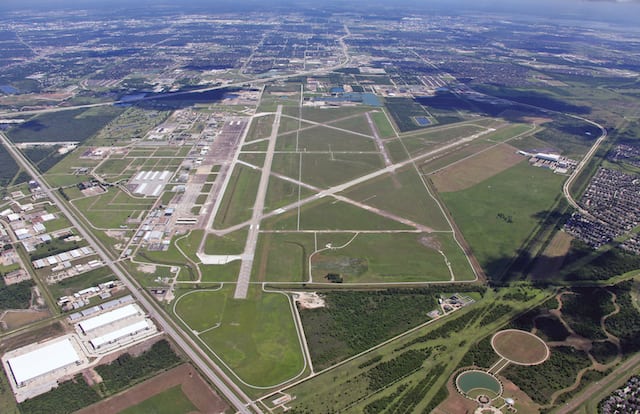
An aerial view of Ellington Airport, a mixed-use airfield located in Houston, Texas. Photo courtesy of Houston Airports
U.S. lawmakers will consider the FAA’s future role as the nation’s air navigation service provider (ANSP) Wednesday, during a U.S. House Transportation and Infrastructure Committee meeting. Lawmakers will consider a proposal that committee’s chairman, Bill Shuster, has been pushing in recent years that would separate the FAA’s role as the U.S. aviation safety regulator from its role as the nation’s ANSP, with an aim to establish a federally chartered air traffic control (ATC) corporation.
In place of providing a long-term operational budget for the FAA, Congress has passed several temporary extensions to keep funding the FAA under its current structure since 2015. In February 2016, the U.S. House Transportation Committee approved the Aviation Innovation, Reform, and Reauthorization (AIRR) Act, which was never actually signed into law, but provides a blueprint to how some lawmakers and members of the aviation community want to reform the structure of the FAA. Under the act, a board representing commercial airline, general aviation and other segments of airspace users, as well as representatives providing public interest, would govern the federally chartered ATC corporation.
On Feb. 9, 2017, President Donald Trump met with several U.S. airline and airport executives and expressed support for changing the structure. However, the president went a step further in his support to remove the FAA’s role as the nation’s ANSP, when the White House released its 2018 budget blueprint calling for shifting the FAA’s management of the air traffic system to “an independent, non-governmental organization,” making it seem more likely that the future of the FAA could look a lot different than it does today.
According to a summary of the subject matter of Wednesday’s meeting released by the committee on transportation and infrastructure, Paul Rinaldi, president of the National Air Traffic Controllers Assn., (NATCA) will be among the witnesses providing expert testimony for lawmakers. Rinaldi has already expressed support for reforming the FAA and creating a new entity responsible for managing and modernizing the air traffic system and infrastructure.
The committee was critical of the FAA’s NextGen air traffic modernization program within its announcement of the hearing as well, specifically criticizing the FAA’s automatic dependent surveillance-broadcast (ADS-B) out program. The announcement noted that the FAA had originally touted ADS-B as a “way to help free up congested airspace and enable more capacity” and established its 2020 ADS-B out equipage mandate in 2010.
The biggest opposition to the proposed reform has come from the business aviation community, led by National Business Aviation Assn. (NBAA) President and CEO Ed Bolen. Although the spending bill to keep funding several government agencies through Sept. 30 was signed into law recently, it did not include language to separate the ATC function from the current FAA structure. Bolen released the following statement:
“We are pleased that the language accompanying the bill underscores the concerns over ATC privatization that have long been raised by NBAA and other organizations, as well as by federal and local elected officials, and most voters.”
As part of the hearing Wednesday, lawmakers will review progress with NextGen under the current FAA structure, as well as the results seen by other countries that have separated their government’s role as the aviation safety regulator from its role as ANSP.